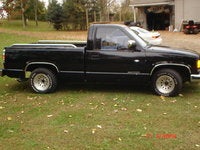1998 chevy k1500
Asked by Hunter270i Dec 31, 2015 at 03:23 PM about the 1998 Chevrolet C/K 1500
Question type: Maintenance & Repair
I been having electrical issues all at once, I just
replaced wiper motor, blinker combo switch and
now I don't have night tail lights or park lights. But I
have brake lights and blinkers.
4 Answers
did you have night tail lights or park lights befor the switch change?? do you have power comming out of it..to the rear lights?
dane808tup answered 8 years ago
you changed those items because you thought you have bad bulbs and bad switches. I can't comment on the wiper motor, probably coincidental. at any rate, what you have is more than likely a wiring issue, or bad fuses. solve those, and I am willing to bet if you put in the old bulbs and switches, they will work
dane808tup answered 8 years ago
you will need to get a electrical schematic to those wiring circuits. If you can't locate them, then at least determine positively that you are NO GETTING power to the lights and switches using a multimeter..excercise the switches to those lights and see if you have power..same with the combo blinker switch....you may find you are not getting any electrical power ...and that positively indicates some type of wiring issue. and check all of your grounds. They are located in MULTIPLE locations throughout the vehicle. an electrical schematic is very helpful and efficient in seeing where those wiring circuits are routed, and from where they get power..as well as the ground binding locations. the general practice of swapping bulbs and switches to solve electrical issues is OK, but expensive, as the number of parts to solve electrical issues can add up..something to think about before running out and buying more parts! do the electrical troubleshooting first..always...it helps you learn so that when a more serious issue comes up, you might be able to save yourself alot of money and time, knowing how to do it. Lighting electrical is about as basic to learn. we call it continuity checks...(see if the wire is broken and cannot transfer current..an "open"...means you will not get power. FIX: Repair or replace broken wire. we call resistance checks: if the wire passes a continuity check it can still be damaged. Like a wire that is almost completely broken, just with barely enough wire to pass continuity..but under nominal load, it cannot carry enough current. Often this is a wire that has insulation torn, and wires exposed and touching something else, or even when both wire (or more) are touching each other through exposed chafed wiring insulation. There are some simple ways to determine this...If it passes continuty, but fails a resistance check. (like you are getting a very high resistance (ohms) reading) you are sure there is some kind of issue..sometimes it is a loose or corroded connector...sometimes it is the bulb receptacle or switch itself...internal parts corroded or broken pieces, or some kind of malformed parts...sometimes from heat...sometimes from old age..crumbly.another test, another test to check during continuity is a simple "shake test"...you set up your multi-meter and "ring" for continuity..and then shake that wire. if you lose continuity, you probably have a semi broken wire, or where you are causing it to jump from the working state to the open non working state back and forth. this test takes some skill and attention to detail. You can have a false positive if you are not making absolutely sure you meter is properly connected at all time during the test...do it multiple times and shake the wire and different segments. especially at connectors ...so this same test for resistance if it passes in continuity. Same principle...if you have a problem with wiring your meter will show a reading change when you move the wire. another method..and this one is simple, if you have the proper wire size and length, is to simply bypass the entire existing wiring circuit ...what you would be doing is creating a known good circuit that you can connect from the power source to the load source (switch to light)...if you get power and your bulbs work..then you absolutely KNOW it is not the switch or the bulb, but the problem IS located in the wire that you mypassed. It is a crude but very simple way to determine wire faults...the results you get are also very helpful because they give you results that are dependable and not subject to second guessing... on grounding/bonding issues. in cars ground wires are used throughout in order for just about everything electrical to function. All of them MUST be a good condition..the most common problem with grounds is corrosion ...that somtimes causes them to break or snap. if you find a schematic, look at the grounds for your lights and switches..and then find them on the care. Carefully remove each of them, clean off all corrosion (a emery cloth used "sand" the metal connectors until they look like shiny metal..and also on the frame where the ground point is located..and look at the wire that are crimped into the connectors...look for corrosion there also, and clean them. look for broken wires...make sure the bolts and nuts used to secure the wires to the frame are not corroded.! clean them up also...reassemble your ground wires and connectors, and make sure the bolts and nuts are nice and tight. then apply silicone grease..or a cheap dielectric grease...not required...but will help eliminate corrosion in the future..may as well do it while you are down there! summary: getting a copy of the schematic for your vehicle is probably the best thing you can do...google it..you will be suprised how easy they are to find and mostly freee...become a member of a car forum..or two...you will find have other folks might have exactly the schematic and good advice about your lighting issues.. good luck and happy new year.
